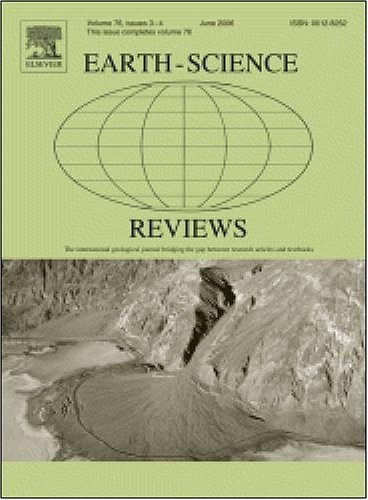Relationships between African landforms, regolith materials, and Cenozoic climate change: Implications for sedimentary source-to-sink systems
IF 10
1区 地球科学
Q1 GEOSCIENCES, MULTIDISCIPLINARY
引用次数: 0
Abstract
This review of landform-regolith associations at a reference locality in Burkina Faso decodes the 50-million-year long paleoclimatic imprint on the African landscape. Stepwise morpho-pedogenesis formed a sequence of landform-regolith associations, offering insights into surface evolution processes at successive landscape stages. The landscape evolved in response to wet-to-dry climatic transitions at ca. 34(?), 24, 11, 6, and 2.9 Ma, with each shift leading to the formation of pediments that were weathered and cemented by iron duricrusts after subsequent dry-to-wet shifts at around 29, 18, 7, and 3.4 Ma. This evolution resulted in (i) sequential dispersion and recycling of Paleogene regolith on pediment surfaces, and (ii) regolith (i.e., clastic sediments) delivery to rivers during dry periods at 34(?)–29 Ma, 24–18 Ma, 11–7 Ma, 6–3.4 Ma, and 2.9–0 Ma. The time laps between regolith production in weathering profiles and its fluvial discharge can be >40 My, necessitating caution in paleoclimatic interpretations of the sink sedimentary record. Shifts in the nature of regolith delivery are anticipated at ∼24 Ma (end of extremely warm and wet climatic regimes) and at ∼6 Ma (settling of the modern latitudinal climatic zonation over Northern Africa). Very-slow and steady base-level lowering (<3.5 m/My since 45 Ma) responded to the very long-term sequence of eustatic sea-level fall since the Early Eocene. The morpho-pedogenetic evolution produced a landscape with its highest reliefs composed of weak, weathering-prone lithologies protected by iron-rich duricrusts. Regolith recycling implies that without detailed geomorphological, petrographic, and sedimentological field investigations, the geochronological characterization of the regolith can be misleading for paleoclimatic, morphogenetic and source-to-sink studies. This review provides an updated landscape evolution model for Northwestern Africa and highlights the potential of mapping landform-regolith associations as paleoclimatic markers, with broad applicability to Cenozoic continental surface dynamics. Landform-regolith mapping is proving a key tool to assess tropical geodiversity, which is shown to have increased since 45 Ma as a result of the diversification of the successive landform-regolith associations.
非洲地貌、风化物质与新生代气候变化之间的关系:对沉积源-汇系统的影响
在布基纳法索的一个参考地点,对地形-风化关联的回顾解码了非洲景观上5000万年的古气候印记。阶梯式的地貌-土成作用形成了一系列地貌-风土结合,为了解连续景观阶段的地表演化过程提供了洞见。在约34(1)、24、11、6和2.9 Ma的干湿气候转变中,景观的演变是对气候变化的响应,每次转变都会导致山墙的形成,这些山墙在随后的29、18、7和3.4 Ma的干湿转变后被铁质硬壳风化和胶结。这种演化导致(i)古近系风化层在山墙表面的顺序分散和再循环,以及(ii)风化层(即碎屑沉积物)在34(1)-29 Ma, 24-18 Ma, 11-7 Ma, 6-3.4 Ma和2.9-0 Ma的干旱时期向河流输送。风化剖面上的风化层产生与河流排出之间的时间间隔可能为40分钟,因此在对沉积记录进行古气候解释时需要谨慎。预计在~24 Ma(极端温暖和潮湿气候制度的结束)和~6 Ma(北非纬向气候带的沉降)时,风化层输送性质会发生变化。非常缓慢和稳定的基准面下降(45 Ma以来的3.5 m/ m)响应了早始新世以来非常长期的海平面上升序列。形态-成土演化形成了这样一幅地貌,其最高的地形由脆弱的、易风化的岩性组成,受富铁硬壳的保护。风化层再循环意味着,如果没有详细的地貌、岩石学和沉积学实地调查,风化层的年代学特征可能会误导古气候、形态发生和源-汇研究。这篇综述为西北非洲提供了一个更新的景观演化模型,并强调了绘制地貌-风化关联作为古气候标志的潜力,在新生代大陆表面动力学方面具有广泛的适用性。地形-风化层制图被证明是评估热带地质多样性的关键工具,自45 Ma以来,由于连续的地形-风化层组合的多样化,热带地质多样性有所增加。
本文章由计算机程序翻译,如有差异,请以英文原文为准。
求助全文
约1分钟内获得全文
求助全文
来源期刊

Earth-Science Reviews
地学-地球科学综合
CiteScore
21.70
自引率
5.80%
发文量
294
审稿时长
15.1 weeks
期刊介绍:
Covering a much wider field than the usual specialist journals, Earth Science Reviews publishes review articles dealing with all aspects of Earth Sciences, and is an important vehicle for allowing readers to see their particular interest related to the Earth Sciences as a whole.
 求助内容:
求助内容: 应助结果提醒方式:
应助结果提醒方式:


